|
|
|
Sort Order |
|
|
|
Items / Page
|
|
|
|
|
|
|
| Srl | Item |
| 1 |
ID:
095004


|
|
|
|
|
| Publication |
2010.
|
| Summary/Abstract |
The article uses the case of Basmati to identify a number of problems concerning geographical indications, including the interface with trademarks and the issue of genericity. Attempts to enter and free-ride on Basmati's premium rice market include the use of trademarks and (RiceTec's US) patent. Reviewing these, the article notes the subject matter of geographical indications can be implicated by other forms of intellectual property, such as patents. The case of Basmati is all the more problematic because of its transborder reality for which no provisions exist in the Agreement on the Trade-Related Aspect of Intellectual Property Rights (TRIPS). The article outlines and discusses various institutional models for a joint registration of Basmati between India and Pakistan as a possible solution for the TRIPS requirement of "home protection" (compare article 24.9).
|
|
|
|
|
|
|
|
|
|
|
|
|
|
|
|
| 2 |
ID:
095006


|
|
|
|
|
| Publication |
2010.
|
| Summary/Abstract |
In debates in the World Trade Organization over the protection of geographical indications (GIs), the European Union (EU) has framed its position in terms of the potential for GIs to protect local cultures, offer a quality guarantee to consumers, and provide opportunities for value-added agriculture. A key tenet of the EU's argument is that GI schemes can be successfully implemented in developing countries as well as Europe. However, my analysis of the case of tequila shows that GIs in developing countries face unique challenges. Tequila is the oldest GI outside of Europe, and is often cited as an example of a successful GI in a developing country. Despite obvious successes in terms of its market share, however, the GI for tequila has largely failed to benefit the local population and environment. My examination of the tequila case illustrates how, throughout the history of the evolving GI legislation for tequila, influential actors have manipulated production standards in ways that contradict the theoretical concept of a GI and negatively affect the overall quality of tequila. I situate this case within the larger framework of international legislation on GIs, arguing that higher standards and a more context-specific approach are necessary.
|
|
|
|
|
|
|
|
|
|
|
|
|
|
|
|
| 3 |
ID:
095007
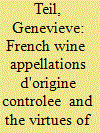

|
|
|
|
|
| Publication |
2010.
|
| Summary/Abstract |
There is something highly paradoxical about the French wine Appellations d'Origine Contrôlées (AOCs): the more they are considered to be suspect, the more they expand to other countries and products! Since their invention they have been suspected of not conveying reliable information. At the same time, supporters of quality wine have prayed for the development of a quality wine market and seen the suspicions concerning them as a threat that these actors have collectively tried to answer. But neither the accusation nor the defence has managed to close the debate. Accusation after accusation, the assessors acknowledgement of being able to define quality have changed, as has quality itself and the role given to AOCs. Far from sweeping away the old procedures, the new solutions have cohabited with them, transforming the wine market into a complex market hosting hundreds of thousands of brands and a variety of uses of quality signs by wine drinkers. Finally, contrary to most economists' fears, neither AOCs nor quality itself work by imposing themselves on the market actors. The greatest strength of AOCs may not be an ability to deceive consumers, but their capacity to raise doubts and to trigger considerable efforts by their defenders to quieten them.
|
|
|
|
|
|
|
|
|
|
|
|
|
|
|
|
| 4 |
ID:
095008
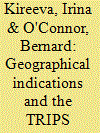

|
|
|
|
|
| Publication |
2010.
|
| Summary/Abstract |
The World Trade Organization (WTO) Agreement on Trade-Related Aspects of Intellectual Property Rights was the first multilateral international treaty (although not the first international treaty) to define and protect geographical indications (GIs) as a specific intellectual property type. There is some debate as to whether the agreement specifies the manner in which WTO members are to implement the protection or mandates a separate system for the protection of GIs (so-called "sui generis" protection). Rather than contributing further to this debate, this article provides a comprehensive overview of the means by which various WTO members have implemented the commitment to protect national and foreign GIs. In addition, the article looks at some examples of protected names in different jurisdictions and some of the problems encountered in registering GIs from outside the country effecting the protection.
|
|
|
|
|
|
|
|
|
|
|
|
|
|
|
|
| 5 |
ID:
095009
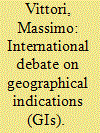

|
|
|
|
|
| Publication |
2010.
|
| Summary/Abstract |
Geographical indications (GIs) have progressively become a global phenomenon. The Agreement on Trade-Related Aspects of Intellectual Property has recognized GIs as a major category of intellectual property. Some 76 countries protect GIs today through specific legal systems (commonly referred to as sui generis), which provide for the registration of geographical names as a separate kind of intellectual property right. However, from the point of view of producers, several issues remain to be clarified in the international debate over GIs. First of all, the international rules do not provide the interested parties with effective legal remedies to stop infringements. As a result, unlawful uses of protected names have been increasing over the years. Monitoring GIs and reaching out to relevant enforcement authorities to denounce any eventual abuse are becoming complex and expensive tasks. Finally, in several countries, in spite of a tremendous potential, producers and policy-makers have not yet fully grasped the role of GI in terms of sustainable development. In light of the above, the purpose of this article is to provide an overview of the major issues characterizing the international debate over GIs and present the strategy adopted by the global coalition of GI producers-oriGIn-to address those problems.
|
|
|
|
|
|
|
|
|
|
|
|
|
|
|
|
| 6 |
ID:
095002
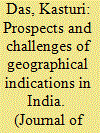

|
|
|
|
|
| Publication |
2010.
|
| Summary/Abstract |
In the recent past, geographical indications (GIs) have emerged as a significant intellectual property rights issue in the Indian context. Since 15 September 2003, when the Indian GI Act came into force, more than a hundred Indian products have been registered as GIs. However, there are several practical challenges confronting the stakeholders in India when it comes to the realization of the potential benefits ingrained in GIs. Apart from effective enforcement of the rights in the relevant markets (domestic and export), the success of a GI is contingent, in a large measure, upon appropriate marketing and promotion of the product-tasks that are not only resource-intensive but also challenging to execute for many stakeholders from a developing country like India. It is all the more tricky to ensure that a fair share of the benefits accruing from the GI status of a product reaches the actual producers/artisans downstream in the supply chain, unless an appropriate institutional mechanism is set in place towards that end. Against this backdrop, the article attempts to explore the prospects for India in exploiting the potential benefits embedded in GIs and the key challenges confronting the country in its endeavour to realize such benefits.
|
|
|
|
|
|
|
|
|
|
|
|
|
|
|
|
| 7 |
ID:
095000
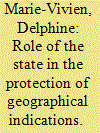

|
|
|
|
|
| Publication |
2010.
|
| Summary/Abstract |
Geographical indications (GIs) are remarkably different from other instruments of intellectual property rights (IPRs). Their acreage to the local provides an original scheme of governance. Contrary to other IPRs, GIs have only been homogenized in a very small way in the international legal framework. The issue is whether GIs are implemented as any other IPR, due to their collective and public dimensions. In particular, what is the role conferred to the state in the protection of GIs? The French legal framework, which largely influenced the European legal framework, is based on long traditions of protection of the appellations of origin and GIs where the role of the state has been declining, in order to give more responsibilities to the producer groups. The control task has been transferred from the state to the certification bodies to increase the guarantee of quality. The Indian experience, a post-TRIPS Agreement (the Agreement on Trade-Related Aspects of Intellectual Property Rights) example, shows a state and its agencies which are very active in the process of filing GI applications, including being themselves the applicant and eventually the proprietor. This might be justified by the lack of strong producer organization. These different roles of the state between France/Europe and India give a new understanding of the legal nature of GIs.
|
|
|
|
|
|
|
|
|
|
|
|
|
|
|
|
|
|
|
|
|